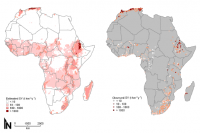Template:TEXT BOX LEFT: Difference between revisions
From CSDMS
No edit summary |
No edit summary |
||
| Line 1: | Line 1: | ||
[[Image: | [[Image:Africa_SY_2014.png|200px|left|link=Science_spotlights#Contemporary_sediment_yields_of_the_continent_Africa]] | ||
In a recent paper, Matthias Vanmaercke et al. (2014) attempt to get a better understanding of what controls the spatial sediment yield (SY) of the continent Africa. This is of importance as most global SY studies underrepresent this continent, despite expected large population increases and climatic changes in the nearby future. By applying correlation analyzes, the spatial difference of SY, observed for 682 catchments, can best be explained by differences in [[Science_spotlights#Contemporary_sediment_yields_of_the_continent_Africa|more...]]<br><br>[mailto:csdmsweb@colorado.edu Nominate a science spotlight] | |||
Revision as of 10:47, 30 July 2014
In a recent paper, Matthias Vanmaercke et al. (2014) attempt to get a better understanding of what controls the spatial sediment yield (SY) of the continent Africa. This is of importance as most global SY studies underrepresent this continent, despite expected large population increases and climatic changes in the nearby future. By applying correlation analyzes, the spatial difference of SY, observed for 682 catchments, can best be explained by differences in more...
Nominate a science spotlight

